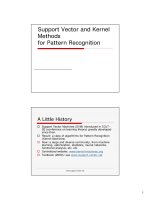support vector and kernel learning
Bạn đang xem bản rút gọn của tài liệu. Xem và tải ngay bản đầy đủ của tài liệu tại đây (733.39 KB, 85 trang )
Support Vector and Kernel
Machines
A Little History
z
SVMs
introduced in COLT
-
92 by
Boser
,
Guyon
,
Vapnik
. Greatly developed ever since.
z
Initially
popularized
in the NIPS community, now an
important and active field of all Machine Learning
research.
z
Special issues of Machine Learning Journal, and
Journal of Machine Learning Research.
z
Kernel Machines: large class of learning algorithms,
SVMs
a particular instance.
A Little History
z
Annual workshop at NIPS
z
Centralized website:
www.kernel
-
machines.org
z
Textbook (2000): see
www.support
-
vector.net
z
Now: a large and diverse community: from machine
learning,
optimization
, statistics, neural networks,
functional analysis, etc. etc
z
Successful applications in many fields (bioinformatics,
text, handwriting recognition, etc)
z
Fast expanding field, EVERYBODY WELCOME !
-
Preliminaries
z
Task of this class of algorithms: detect and
exploit complex patterns in data (
eg
: by
clustering, classifying, ranking, cleaning, etc.
the data)
z
Typical problems: how to represent complex
patterns; and how to exclude spurious
(unstable) patterns (= overfitting)
z
The first is a computational problem; the
second a statistical problem.
Very Informal Reasoning
z
The class of kernel methods
implicitly
defines
the class of possible patterns by introducing a
notion of similarity between data
z
Example: similarity between documents
z
By length
z
By topic
z
By language …
z
Choice of similarity
Î
Choice of relevant
features
More formal reasoning
z
Kernel methods exploit information about the inner
products between data items
z
Many standard algorithms can be rewritten so that they
only require inner products between data (inputs)
z
Kernel functions = inner products in some feature
space (potentially very complex)
z
If kernel given, no need to specify what features of the
data are being used
Just in case …
z
Inner product between vectors
z
Hyperplane
:
x z
x
z
i
i
i
,
=
∑
x
x
o
o
o x
x
o
o
o
x
x
x
w
b
w x
b
,
+
=
0
Overview of the Tutorial
z
Introduce basic concepts with extended
example of Kernel Perceptron
z
Derive Support Vector Machines
z
Other kernel based algorithms
z
Properties and Limitations of Kernels
z
On Kernel Alignment
z
On
Optimizing
Kernel Alignment
Parts I and II: overview
z
Linear Learning Machines (LLM)
z
Kernel Induced Feature Spaces
z
Generalization Theory
z
Optimization
Theory
z
Support Vector Machines (SVM)
Modularity
z
Any kernel
-
based learning algorithm composed of two
modules:
–
A general purpose learning machine
–
A problem specific kernel function
z
Any K
-
B algorithm can be fitted with any kernel
z
Kernels themselves can be constructed in a modular
way
z
Great for software engineering (and for analysis)
IMPORTANT
CONCEPT
1
-
Linear Learning Machines
z
Simplest case: classification. Decision function
is a
hyperplane
in input space
z
The Perceptron Algorithm (
Rosenblatt
, 57)
z
Useful to
analyze
the Perceptron algorithm,
before looking at
SVMs
and Kernel Methods in
general
Basic Notation
z
Input space
z
Output space
z
Hypothesis
z
Real
-
valued:
z
Training Set
z
Test error
z
Dot product
x
X
y Y
h H
f X
S
x
y
x
y
x z
i
i
∈
∈
=
−
+
∈
→
=
{
,
}
:
R
{(
,
),
.
.
.
,
(
,
),
.
.
.
.
}
,
1
1
1
1
ε
Perceptron
z
Linear Separation of the
input space
x
x
o
o
o x
x
o
o
o
x
x
x
w
b
f x
w
x
b
h x
sign
f
x
( )
,
( )
(
(
))
=
+
=
Perceptron Algorithm
Update rule
(ignoring threshold):
z
if then
x
x
o
o
o x
x
o
o
o
x
x
x
w
b
y w
x
i
k
i
( ,
)
≤
0
w
w
y
x
k
k
k
k
i
i
+
←
+
←
+
1
1
η
Observations
z
Solution is a linear combination of training
points
z
Only used informative points (mistake driven)
z
The coefficient of a point in combination
reflects its ‘difficulty’
w
y
x
i
i
i
i
=
≥
∑
α
α
0
Observations
-
2
z
Mistake bound:
z
coefficients are non
-
negative
z
possible to rewrite the algorithm using this alternative
representation
M
R
≤
γ
2
x
x
o
o
o
x
x
o
o
o
x
x
x
g
Dual Representation
The decision function can be re
-
written as
follows:
f x
w
x
b
y
x
x
b
i
i
i
( )
,
,
=
+
=
+
∑
α
w
y
x
i
i
i
=
∑
α
IMPORTANT
CONCEPT
Dual Representation
z
And also the update rule can be rewritten as follows:
z
if then
z
Note: in dual representation, data appears only inside
dot products
y
y
x
x
b
i
j
j
j
i
α
,
∑
+
≤
3
8
0
α
α
η
i
i
←
+
Duality: First Property of
SVMs
z
DUALITY is the first feature of Support Vector
Machines
z
SVMs
are Linear Learning Machines
represented in a dual fashion
z
Data appear only within dot products (in
decision function and in training algorithm)
f x
w
x
b
y
x
x
b
i
i
i
( )
,
,
=
+
=
+
∑
α
Limitations of
LLMs
Linear classifiers cannot deal with
z
Non
-
linearly separable data
z
Noisy data
z
+ this formulation only deals with
vectorial
data
Non
-
Linear Classifiers
z
One solution: creating a net of simple linear
classifiers (neurons): a Neural Network
(problems: local minima; many parameters;
heuristics needed to train; etc)
z
Other solution: map data into a richer feature
space including non
-
linear features, then use a
linear classifier
Learning in the Feature Space
z
Map data into a feature space where they are
linearly separable
x
x
→
φ
(
)
x
x
x
x
o
o
o
o
f (o)
f (x)
f (x)
f (o)
f (o)
f (o)
f (x)
f (x)
f
X
F
Problems with Feature Space
z
Working in high dimensional feature spaces
solves the problem of expressing complex
functions
BUT:
z
There is a computational problem (working with
very large vectors)
z
And a generalization theory problem (curse of
dimensionality)
Implicit Mapping to Feature Space
We will introduce Kernels:
z
Solve the
computational
problem of working
with many dimensions
z
Can make it possible to use infinite dimensions
–
efficiently in time / space
z
Other advantages, both practical and
conceptual
Kernel
-
Induced Feature Spaces
z
In the dual representation, the data points only
appear inside dot products:
z
The dimensionality of space F not necessarily
important. May not even know the map
f x
y
x
x
b
i
i
i
( )
(
,
(
)
)
=
+
∑
α
φ
φ
φ









